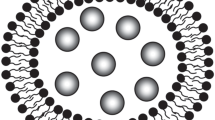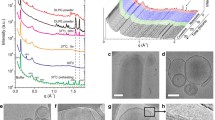Abstract
Physical stability is one of critical characteristics of liposome, especially to its clinical application. Vesicle fusion was one of the common physical stability phenomena that occurred during the long storage period. Because vesicle fusion could be easily checked by the change of vesicle size, it was widely applied in the evaluation of liposome physical stability. However, since the method requires the liposome to be placed under certain conditions for long-term observation, a liposome physical stability test usually takes several weeks, which greatly hinders the research efficiency. In this study, to speed up the research efficiency, coarse-grained molecular dynamics was first applied in the study of liposome physical stability. By analyzing the microprocess of vesicle fusion, two parameters including diffusion constant and the total time of the vesicle morphology transition process were employed to study the liposome physical stability. Then, in order to verify the applicability of two parameters, the physical stability of elastic liposomes and conventional liposomes was compared at 3 different temperatures. It was found that the fusion probability and speed of elastic liposomes were higher than those of conventional liposomes. Thus, elastic liposomes showed a worse physical stability compared with that of conventional liposomes, which was consistent with former research. Through this research, a new efficient method based on coarse-grained molecular dynamics was proposed for the study of liposome physical stability.








Similar content being viewed by others
References
Felice B, Prabhakaran MP, Rodríguez AP, Ramakrishna S. Drug delivery vehicles on a nano-engineering perspective. Mater Sci Eng C Mater Biol Appl. 2014;41:178–95.
Pastore MN, Kalia YN, Horstmann M, Roberts MS. Transdermal patches: history, development and pharmacology. Br J Pharmacol. 2015;172(9):2179–209.
Abu Lila AS, Ishida T. Liposomal delivery systems: design optimization and current applications. Biol Pharm Bull. 2017;40(1):1–10.
Crommelin DJA. Influence of lipid composition and ionic strength on the physical stability of liposomes. J Pharm Sci. 1984;73(11):1559–63.
Yotsuyanagi T, et al. Effect of cholesterol on liposome stability to ultrasonic disintegration and sodium cholate solubilization. Chem Pharm Bull (Tokyo). 1987;35(3):1228–33.
Brown PM, Silvius JR. Stability and fusion of lipid vesicles containing headgroup-modified analogues of phosphatidylethanolamine. Biochim Biophys Acta. 1989;980(2):181–90.
Armengol X, Estelrich J. Physical stability of different liposome compositions obtained by extrusion method. J Microencapsul. 1995;12(5):525–35.
Casals E, Galán AḾ, Escolar G, Gallardo M, Estelrich J. Physical stability of liposomes bearing hemostatic activity. Chem Phys Lipids. 2003;125(2):139–46.
Muller M, Katsov K, Schick M. Biological and synthetic membranes: what can be learned from a coarse-grained description? Phys Rep. 2006;434(5–6):113–76.
Shillcock JC, Lipowsky R. The computational route from bilayer membranes to vesicle fusion. J Phys Condens Matter. 2006;18(28):S1191–219.
Marrink SJ, de Vries AH, Tieleman DP. Lipids on the move: simulations of membrane pores, domains, stalks and curves. Biochim Biophys Acta. 2009;1788(1):149–68.
Fuhrmans M, Marelli G, Smirnova YG, Müller M. Mechanics of membrane fusion/pore formation. Chem Phys Lipids. 2015;185:109–28.
Promsri S, Ullmann GM, Hannongbua S. Molecular dynamics simulation of HIV-1 fusion domain-membrane complexes: insight into the N-terminal gp41 fusion mechanism. Biophys Chem. 2012;170:9–16.
Li R, Song D, Zhu Z, Xu H, Liu S. An induced pocket for the binding of potent fusion inhibitor CL-385319 with H5N1 influenza virus hemagglutinin. PLoS One. 2012;7(8):e41956.
Iliopoulou M, Nolan R, Alvarez L, Watanabe Y, Coomer CA, Jakobsdottir GM, et al. A dynamic three-step mechanism drives the HIV-1 pre-fusion reaction. Nat Struct Mol Biol. 2018;25(9):814–22.
Larsson P, Kasson PM. Lipid tail protrusion in simulations predicts fusogenic activity of influenza fusion peptide mutants and conformational models. PLoS Comput Biol. 2013;9(3):e1002950.
Chien L, Chen WK, Liu ST, Chang CR, Kao MC, Chen KW, et al. Low-dose ionizing radiation induces mitochondrial fusion and increases expression of mitochondrial complexes I and III in hippocampal neurons. Oncotarget. 2015;6(31):30628–39.
Falkenstein K, De Lozanne A. Dictyostelium LvsB has a regulatory role in endosomal vesicle fusion. J Cell Sci. 2014;127(Pt 20):4356–67.
Sharma S, Lindau M. Molecular mechanism of fusion pore formation driven by the neuronal SNARE complex. Proc Natl Acad Sci U S A. 2018;115(50):12751–6.
McDargh ZA, Polley A, O’Shaughnessy B. SNARE-mediated membrane fusion is a two-stage process driven by entropic forces. FEBS Lett. 2018;592(21):3504–15.
Risselada HJ, Kutzner C, Grubmuller H. Caught in the act: visualization of SNARE-mediated fusion events in molecular detail. Chembiochem. 2011;12(7):1049–55.
Tsai HH, Chang CM, Lee JB. Multi-step formation of a hemifusion diaphragm for vesicle fusion revealed by all-atom molecular dynamics simulations. Biochim Biophys Acta. 2014;1838(6):1529–35.
Marrink SJ, Mark AE. The mechanism of vesicle fusion as revealed by molecular dynamics simulations. J Am Chem Soc. 2003;125(37):11144–5.
Shillcock JC. Vesicles and vesicle fusion: coarse-grained simulations. Methods Mol Biol. 2013;924:659–97.
Arnarez C, Uusitalo JJ, Masman MF, Ingólfsson HI, de Jong DH, Melo MN, et al. Dry Martini, a coarse-grained force field for lipid membrane simulations with implicit solvent. J Chem Theory Comput. 2015;11(1):260–75.
Liu YT, Li YR, Wang X. Dynamic evolution of a vesicle formed by comb-like block copolymer-tethered nanoparticles: a dissipative particle dynamics simulation study. Phys Chem Chem Phys. 2017;19(40):27313–9.
Kasson PM, Pande VS. Control of membrane fusion mechanism by lipid composition: predictions from ensemble molecular dynamics. PLoS Comput Biol. 2007;3(11):e220.
Kawamoto S, Klein ML, Shinoda W. Coarse-grained molecular dynamics study of membrane fusion: curvature effects on free energy barriers along the stalk mechanism. J Chem Phys. 2015;143(24):243112.
Elhissi AMA, Giebultowicz J, Stec AA, Wroczynski P, Ahmed W, Alhnan MA, et al. Nebulization of ultradeformable liposomes: the influence of aerosolization mechanism and formulation excipients. Int J Pharm. 2012;436(1–2):519–26.
Benson HA. Elastic liposomes for topical and transdermal drug delivery. Curr Drug Deliv. 2009;6(3):217–26.
Hussain A, Singh S, Sharma D, Webster T, Shafaat K, Faruk A. Elastic liposomes as novel carriers: recent advances in drug delivery. Int J Nanomedicine. 2017;12:5087–108.
Kawamoto S, Shinoda W. Free energy analysis along the stalk mechanism of membrane fusion. Soft Matter. 2014;10(17):3048–54.




